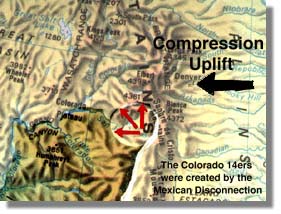The Rocky Mountains form the continental divide and are generally the product of the continent's movement west on the North American plate and its subduction of the sea floor at its western edge. However, the Colorado Rockies are much higher and have younger features that are not easily attributed to the subduction scenario.
There are two issues that suggest that the Mexican Disconnection is the source of the Colorado Rockies difference.
The first is the significant volcanism that has occurred in the Colorado Rockies during the last two million years and the second is the type and direction of the faults in the region of greatest height.
The Mexican Disconnection theory would suggest that northward pressure rather than westward pressure caused the most recent rise and that the volcanoes are due to deep fissures allowing lithospheric magma to rise, rather than bubbles of silicate melt from suducted material. Both types are present in the region, but the most recent volcanoes should be lithoshperic magma if the MD theory is right.
 The Colorado 14ers are evidence of the Mexican Disconnection Theory. There are fifty-four mountains over fourteen thousand feet elevation in Colorado, remnants of a high plateau that eroded during the last several million years.
The Colorado 14ers are evidence of the Mexican Disconnection Theory. There are fifty-four mountains over fourteen thousand feet elevation in Colorado, remnants of a high plateau that eroded during the last several million years.